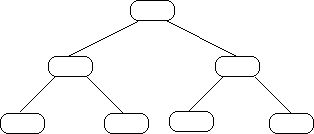
In a linear structure, every element has unique successor.
In trees, may have many.

An edge connects a node to its subtrees.
The roots of the subtrees of a node are said to be the successors or descendants of the node.
There may be many nodes without any successors: These are called leaves. The others are called interior nodes.
All nodes except root have unique predecessor.
A collection of trees is called a forest.
Examples
A) binary search (or sort) tree
K, C, A, N, B, V, F, U, D, H, M
B) Expression trees
[A*(B-C)]+(D/~E)
Family tree terminology:
parent, child, sibling, ancestor, descendant
Node plus all of its descendents is called a subtree.
Simple path is series of distinct nodes such that there is an edge between successive nodes.
path length = number of nodes on path - 1 = # edges traversed in path,
height of node = length of longest path from that node to a leaf.
Height of tree = height of its root.
Depth of node is length of path from root to that node.
Degree of node is number of its direct descendents.
Level defined recursively:
Root is at level 0.
Level of any other node is one greater than level of its parent.
Level of a node also = length of path from root to that node.
We'll stick to binary trees for now! (All nodes of degree <= 2.)
Deal with oriented trees: Identify each subtree as being either left or right.
Lemma: If T is a binary tree, then at level k, T has <= 2k nodes.
Theorem: If T has height h then n = # nodes in T <= 2h+1 -1. Equivalently, if T has n nodes, then n - 1 >= h >= log(n+1) - 1.
Note that these bounds are tight.
A full binary tree of height h has all leaves on level h.
A complete binary tree of height h is obtained from a full binary tree of height h with 0 or more (but not all) of of the rightmost leaves at level h removed.
Say T is balanced if it has the minimum possible height for its # of nodes.
In this case, height = ceiling of log2(n+1) - 1 or O ( log2 n )
Note that a balanced tree may have lots of holes in it.